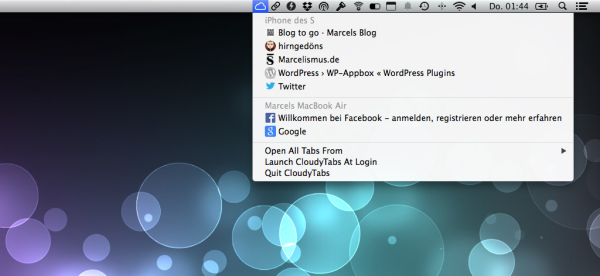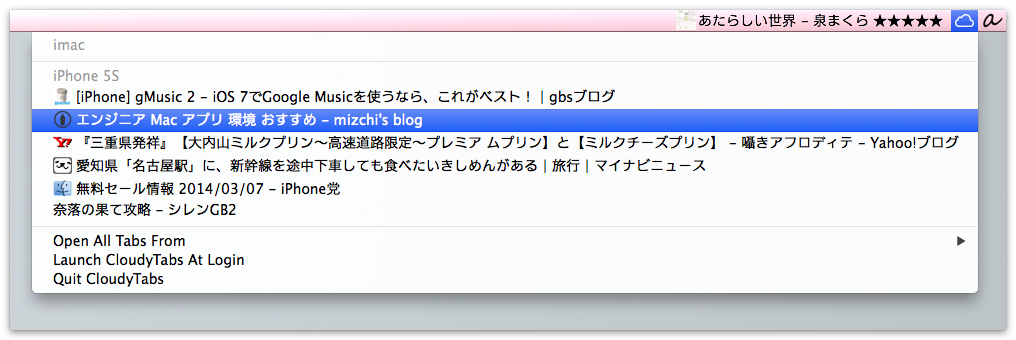- CloudyTabs is a simple menu bar application that lists your iCloud Tabs.
- CloudyTabsis a minimalist OS X status bar menu application designed to help you view the currently opened tabs on all devices connected to your iCloud account. The app will monitor the Safari app.
At a glance
Cons
Tickeys 是一款能够在打字时模拟机械键盘音效的 Windows、OS X 应用,此外还能模拟冒泡、打字机、剑气的音效。@Appinn. Aspiring full-stack software developer from Melbourne, Australia. CloudyTabs is an app that sits in your menubar and shows you all your open tabs on different devices. Click on one and it opens in your default browser on your Mac.
Our Verdict
Everyone has their favorite (or least favorite, depending on how you look at it) beefs with Apple’s iCloud service. But one of my biggest frustrations is that many of iCloud’s most-convenient features require you to use Apple’s apps—those features simply don’t work with third-party programs.
Take iCloud Tabs, the feature that automatically syncs any open Safari tabs across all your OS X and iOS devices. The key word here is Safari—iCloud Tabs doesn’t support other browsers. But this is where third-party developers step in to help. Like previous Gem MyPhotostream, Josh Parnham’s free CloudyTabs is a simple OS X app that lets you liberate a little bit of iCloud—in this case, that bit is iCloud Tabs.
CloudyTabs, which requires OS X 10.8.2 or later, provides a simple systemwide menu that, at a click, displays all your iCloud Tabs, organized by the device hosting each tab. Each open-tab entry displays the tab’s webpage title and favicon. Choosing any item in the menu opens that tab—and here’s the kicker for non-Safari users—in your default browser, whichever browser that may be. (It’s a little strange that CloudyTabs displays your current Mac’s tabs, though I suppose that’s one easy way to shuttle tabs between, say, Safari and Chrome on the same machine.)
Though it’s a simple app, CloudyTabs does offer a few options. You can choose to simultaneously open all tabs from a particular device—for example, all the webpages you’ve got open on your iPhone. Holding down the Command key when you choose an entry (or hovering the pointer over an item and then pressing Return) opens that tab in the background (i.e., without bringing the browser to the foreground). And you can see when your iCloud Tabs were last synced by hovering the pointer over CloudyTabs’s menu-bar icon.
While I appreciate CloudyTabs’s simplicity, there are some additional features I’d like to see. For example, it’d be great to be able to choose, on the fly, which browser a tab will open in. (Safari is my default browser, but I often use Chrome for webpages that contain Flash videos, for example.) Also, some web servers—Wikipedia is one—present the mobile version of pages when loaded in iOS Safari; it would be nice if CloudyTabs could detect that and provide the URL for the desktop version on the Mac. And a keyboard shortcut for accessing the CloudyTabs menu would be useful. (Once the menu is displayed, you can type the name of a page in the menu to select it, but you still must still use the pointer first to open the menu.) But these would simply be icing on the cake of the basic features CloudyTabs already provides.
Uncode wordpress theme. For those who flit between multiple browsers, CloudyTabs can be be a useful tool.
(It’s worth noting that Google offers a feature similar to iCloud Tabs, but you have to be using Chrome on both OS X and iOS.) Usb flash drives for mac.
Want to find out about more cool Mac apps? Check out our Mac Gems session at Macworld/iWorld in San Francisco March 27-29. Want to stay up to date with the latest Gems? You can follow Mac Gems on Twitter or on App.net. You can also subscribe to the Mac Gems RSS feed.
Set up iCloud Tabs
Complete these steps on all of the devices where you want to share tabs.
On your iPhone, iPad, or iPod touch
- Go to Settings > [your name] > iCloud.
- Make sure that Safari is on.
On your Mac
- Choose Apple menu > System Preferences, and click Apple ID. Then click iCloud.
- Click to turn on Safari.
If you’re using macOS Mojave or earlier, choose Apple menu > System Preferences, and click iCloud. Click to turn on Safari.
Cloudy Tab
Open a tab

On your iPhone, iPad, or iPod touch
- Open Safari.
- Tap the Tabs button.
- Scroll to the bottom of the list. Below the images of tabs open on your device, you see a list of open tabs from your other supported devices.
- Tap the one you want to open.
On your Mac
- Open Safari.
- Click the Tabs button. Below the images of tabs open on your Mac, you see a list of open tabs from your other supported devices.
- Tap the one you want to open.

Close a tab
Quitting Safari, putting your device to sleep, or turning off your device doesn't remove a tab from the list.
On your iPhone, iPad, or iPod touch
- Open Safari.
- Tap the Tabs button.
- Scroll to the bottom of the list. Below the images of tabs open on your device, you see a list of open tabs from your other supported devices.
- Swipe left on the tab that you want to close, then tap Close.
On your Mac
- Open Safari.
- Click the Tabs button. Below the images of tabs open on your Mac, you see a list of open tabs from your other supported devices.
- Hover the pointer over the tab that you want to close, then click the Close button that appears.
If you can't set up or use iCloud Tabs
iCloud Tabs works between devices running iOS 13 or iPadOS or later and macOS Mojave 10.14.4 or later, or between devices running iOS 12 or earlier and macOS Mojave 10.14.3 or earlier.
- If your iCloud Tabs aren't updating, make sure that you're running the latest iOS or iPadOS on your iPhone, iPad, or iPod touch and the latest macOS on your Mac.
- Check that you signed in to iCloud with the same Apple ID on all of your devices.
Cloudy Tabs Windows
Learn more
Icloud Tabs Not Working
- iCloud bookmarks keep your Safari bookmarks the same across all of your Macs and iOS devices.
- In OS X Yosemite or later, you can also use Handoff to move Safari pages between your Mac and your iOS devices.
- Learn how to set up and use iCloud for Windows.

Comments are closed.